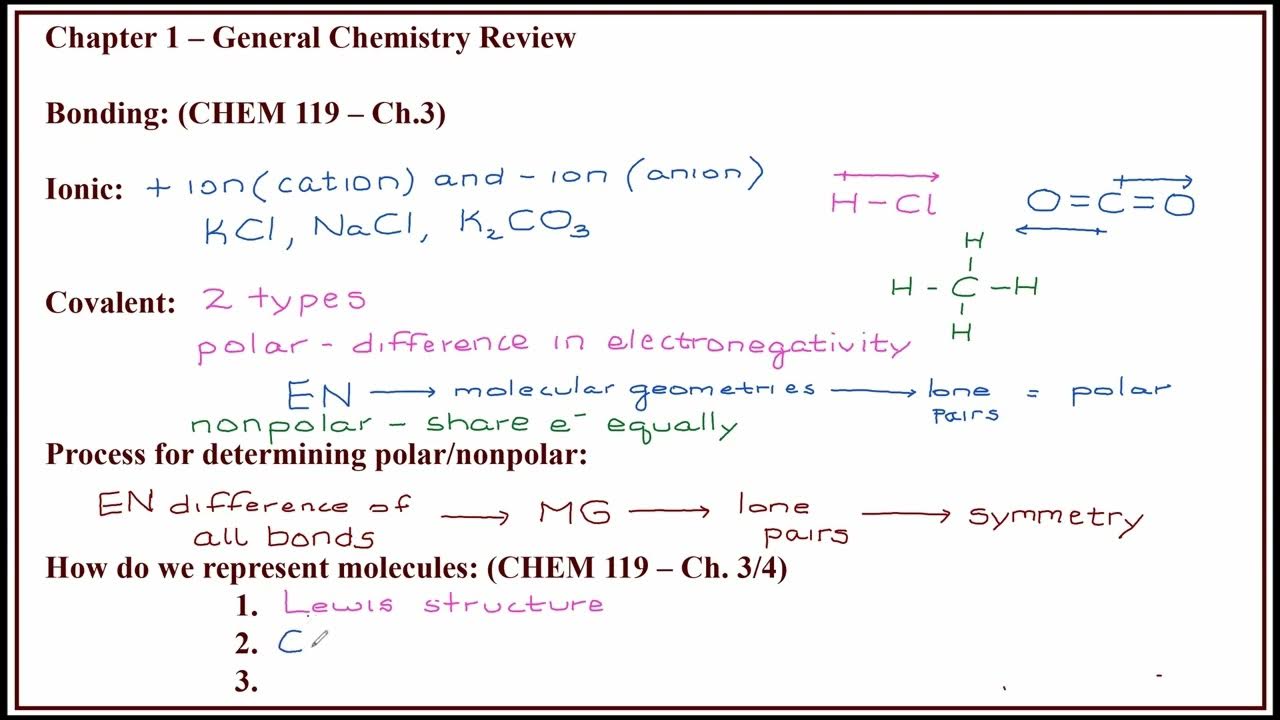Gambarkan struktur Lewis pembentukan senyawa ion berikut! a. BeF2 b. Al2O3 c. Li2O
Summary
TLDRThis video script explains how to draw Lewis structures and understand ionic and covalent bonding. It discusses three compounds: BeF2, Al2O3, and Li2O. BeF2 is highlighted as a covalent compound where beryllium shares electrons with fluorine. Al2O3 forms through the ionic transfer of electrons from aluminum to oxygen, resulting in Al+3 and O-2 ions. Lastly, Li2O illustrates the ionic bond where lithium transfers its electron to oxygen. The script emphasizes electron transfer, valence electrons, and their role in forming stable bonds in these compounds.
Takeaways
- 😀 The Lewis structure for ionic compounds is based on electron transfer between atoms, where one atom donates electrons and the other accepts them.
- 😀 In the case of BeF2, it is not an ionic compound but a covalent compound because beryllium (Be) has a small atomic size, making it unlikely to form ionic bonds.
- 😀 Beryllium (Be) has 4 electrons, with 2 electrons in its outer shell, making it have 2 valence electrons.
- 😀 Fluorine (F), with an atomic number of 9, has 7 valence electrons and requires one electron to achieve an octet.
- 😀 Be and F form a covalent bond in BeF2, with Be sharing its valence electrons with F, resulting in a covalent bond rather than an ionic one.
- 😀 In the case of Al2O3, aluminum (Al) has 13 electrons and 3 valence electrons, which it tends to lose to achieve a stable octet.
- 😀 Oxygen (O), with 8 electrons, has 6 valence electrons and needs 2 more electrons to complete its octet.
- 😀 Aluminum (Al) transfers its 3 valence electrons to oxygen (O), creating Al3+ and O2- ions, resulting in the ionic compound Al2O3.
- 😀 In Li2O, lithium (Li) has 3 electrons, with 1 electron in its valence shell, and it tends to lose this electron to achieve stability.
- 😀 Oxygen (O), with 6 valence electrons, accepts 2 electrons from lithium (Li), resulting in Li+ and O2- ions and forming the ionic compound Li2O.
Q & A
What is the Lewis structure, and why is it important in understanding chemical bonding?
-The Lewis structure represents the arrangement of electrons in atoms or molecules. It is important because it helps visualize how atoms bond, showing the sharing or transfer of electrons between atoms in covalent or ionic bonds.
In the transcript, why is BeF2 described as a covalent compound instead of an ionic one?
-BeF2 is described as covalent because beryllium (Be) has a small atomic size, making it difficult to form ionic bonds. Instead, it shares electrons with fluorine (F) to form covalent bonds, which is why it does not follow typical ionic bonding behavior.
What is the electron configuration for beryllium (Be), and how does it relate to its valence electrons?
-The electron configuration for beryllium (Be) is 1s2 2s2. This means it has 2 valence electrons in its outermost shell, which are involved in bonding with other atoms.
How is the Lewis structure for BeF2 formed, and what type of bond is present between Be and F?
-The Lewis structure for BeF2 is formed by sharing electrons between Be and F. Be contributes 2 valence electrons, and each F atom contributes 7 valence electrons, leading to a single covalent bond between Be and each F.
What are the valence electron configurations for oxygen (O) and aluminum (Al), and how do they contribute to the formation of Al2O3?
-Oxygen has 6 valence electrons, while aluminum has 3 valence electrons. In the formation of Al2O3, aluminum transfers 3 electrons to oxygen, forming an ionic bond where aluminum has a +3 charge and oxygen a -2 charge, creating the compound Al2O3.
Why does aluminum (Al) tend to lose electrons in its bonding process?
-Aluminum tends to lose electrons because it has a low ionization energy and aims to achieve a stable electron configuration (octet) by losing its 3 valence electrons, resulting in a +3 charge.
How does oxygen (O) achieve stability in its bond formation with aluminum?
-Oxygen achieves stability by gaining 2 electrons, completing its octet and acquiring a -2 charge, which balances the +3 charge of aluminum in the ionic compound Al2O3.
What is the significance of the octet rule in the formation of ionic compounds like Al2O3?
-The octet rule is significant because atoms tend to gain, lose, or share electrons to achieve a stable configuration of 8 electrons in their outermost shell. In Al2O3, aluminum loses 3 electrons, and oxygen gains 2, leading to a stable ionic compound.
How does lithium (Li) form an ionic bond with oxygen (O) in Li2O?
-Lithium, with 1 valence electron, donates that electron to oxygen, which needs 2 electrons to complete its octet. This results in the formation of Li2O, where lithium becomes +1 charged and oxygen becomes -2 charged.
What is the relationship between electron configuration and chemical bonding in the compounds discussed?
-Electron configuration determines how atoms interact in chemical bonding. Atoms with incomplete outer electron shells tend to form bonds by either sharing or transferring electrons, as seen in the covalent bonding of BeF2, the ionic bonding of Al2O3, and Li2O.
Outlines

This section is available to paid users only. Please upgrade to access this part.
Upgrade NowMindmap

This section is available to paid users only. Please upgrade to access this part.
Upgrade NowKeywords

This section is available to paid users only. Please upgrade to access this part.
Upgrade NowHighlights

This section is available to paid users only. Please upgrade to access this part.
Upgrade NowTranscripts

This section is available to paid users only. Please upgrade to access this part.
Upgrade Now5.0 / 5 (0 votes)





